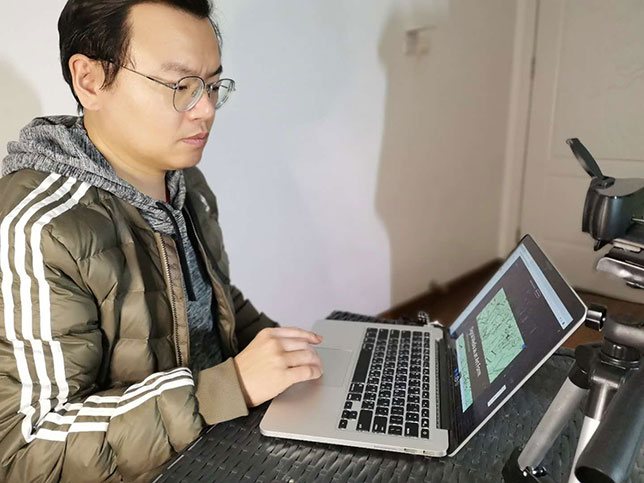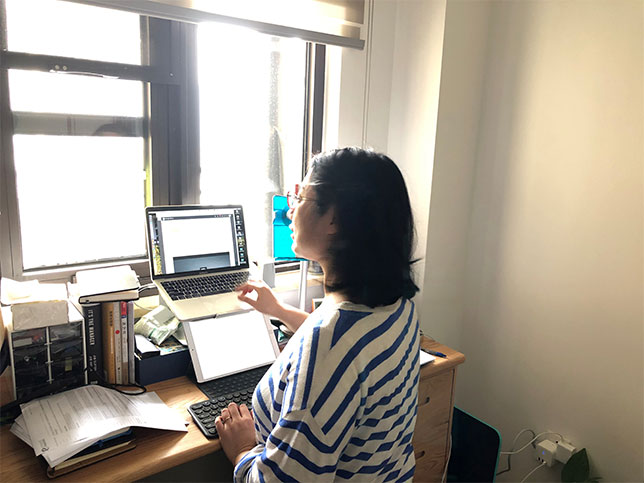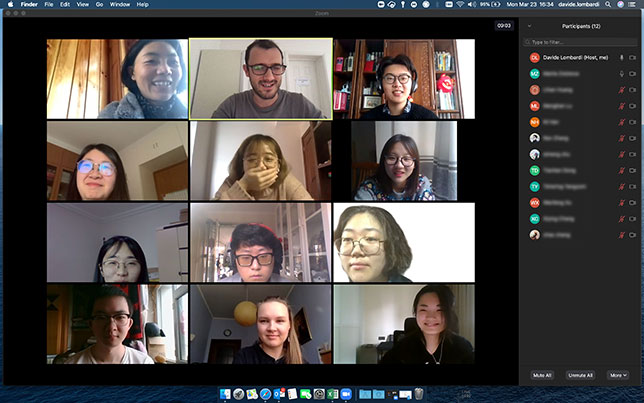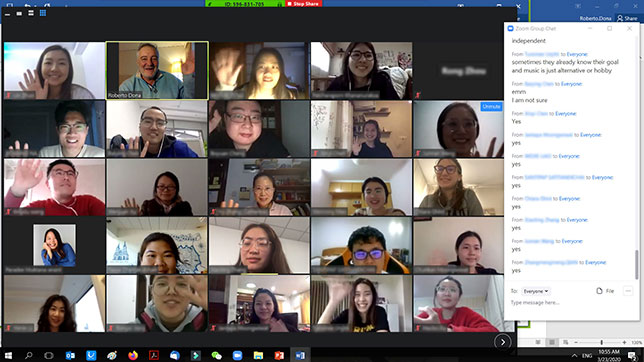Remote Learning on the Fly: Notes from China
While university instructors around the world scramble to implement delivery of their courses online — a medium with which they may have only limited experience — they can learn from the field notes of their counterparts at the largest international joint-venture university in China.
Editor's note: Several weeks ago, Campus Technology profiled Xi'an Jiaotong-Liverpool University's move to online teaching and learning in response to school closures due to coronavirus. In this article, university communications specialist Tamara Kaup shares a progress report.
Moving to all-online instruction requires effort, but if our experience is an example, take heart — it will go just fine.
With a month of fully online teaching under their belts, that's the main message from Xi'an Jiaotong-Liverpool University (XJTLU) instructors to educators in other parts of the world who have more recently begun all-digital instruction as the result of the coronavirus spread.
XJTLU is an international joint university based in Suzhou, Jiangsu, China, located about 50 miles west of Shanghai near the eastern seaboard of China. The school was founded in 2006 from a partnership between UK-based University of Liverpool and Xi'an Jiaotong University in Xi'an, Shaanxi, China. The university has a student body of 14,000, and students and instructors are scattered around the globe. The language of instruction at XJTLU is English.
Not only did the teaching and learning shift caused by COVID-19 require new technical approaches, but the community had to grapple with time zone differences. Yet people from multiple and diverse disciplines have reported that students are achieving course learning objectives, and faculty anticipate adopting newly acquired digital techniques to enhance their onsite instruction in the future.
Small but Useful Beginnings
"When I first realized we would be moving to all-online classes, my first reaction was thinking 'This is going to be hard,' since in the past I hadn't used technology much in my teaching practice. At first, I felt behind the curve in knowing what was available and how to use it," noted Rick Foster, an English language tutor teaching an advanced English writing course in the university's Language Centre. But after attending training sessions provided by the university and trying out the technology, he said, "I was surprised to find that I like using it."
Among the technology Foster's now relying on is web conferencing, with options to switch presenters and turn video cameras and microphones on and off; the ability to record slide presentations with audio or the instructor lectures; public chats; wikis for collaboration; and an interactive whiteboard. "I've given live online classes using BigBlueButton and recorded a video of my computer screen with voiceover using Mediasite to provide a virtual library research demonstration," he said. "To check student engagement, the technology provides us reports on their views and we can see whether they are asking questions in the collaborative wikis or discussion forums."

Cheng-Hung Lo
Cheng-Hung Lo, who is both a senior associate professor in XJTLU's School of Film and TV Arts and a parent of school-age children now learning at home online, has seen up close the effects of online education both on the receiving and giving ends: "Before I tried teaching online, and before I observed my own children's recent online learning experience, I thought these courses might feel less engaging than on-site courses. Instead, I think online courses engage students in a different manner."
As he explained, "In the classroom, the instructor standing in front of the class has a one-to-many relationship with the students. But with online teaching, the student has full focus on the instructor's face and gestures. In a way, online instruction can feel more like a one-to-one conversation between teacher and student."
To help his students unaccustomed to online education get a more familiar experience with online instruction, Paul Cheung, lecturer in the Department of English, made small adjustments. "I sent out practical tips aimed at helping students deal with common issues, which include anything from adjusting audio to how to add shared notes online," he said. "I also try to find ways do the small but useful things that normally happen in a physical setting, such as welcoming students as they enter the virtual classroom."
Eduardo Roldan, from the Department of Health and Environmental Sciences, suggested that creating a sense of classroom is important even when the class can't be together physically. "I asked students to upload video introductions telling the class who they are, what they are studying and what project they want to do for this course. These relatively informal videos create a sense of human connection that might otherwise be missing," he said.
Ramping Up
XJTLU educators observed that preparing for online classes — at least in the beginning — does take time.

Qian Wang
"I ended up spending around 20 hours preparing my first recorded online lecture," said Qian Wang, program director of XJTLU's Institute of Leadership and Education Advanced Development (ILEAD). "When I recorded myself for the first time, I realized how difficult it is for me to talk to a computer instead of a classroom. I ended up recording each part several times and then editing it," she said. "However, while the learning curve was steep, it wasn't long — about a week. Her advice: "Students aren't expecting perfection. Take a risk, make some mistakes — it will be OK."

Davide Lombardi with his students
Davide Lombardi, deputy head of the Department of Architecture + Design, said he has been pleased with the instructors' adaptability. "It's been great to see how well all the staff have been getting along with online instruction," he said. "What could have been a sort of 'Greek tragedy' as the result of a rapid switch to digital tools that were new for some resulted in no major problems to date."
In one of his own classes, a studio course with 11 master's students who are on the cusp of graduating, Lombardi said some things haven't changed. For example, each student still presents the same type of work products he or she would have on campus, including schematics, 3D models or drawings, and "showing how their solutions work for aspects of their design briefs." From there, traditionally, "I or the other instructor argue various points of what the student is presenting to push the student to support their solution." Now, the student uses technology to share "a digital summary of their work like a slideshow on their screen," he said. "They can also share control of their computer with me so that I can work with their 3D model and make real-time adjustments as we discuss. Similar to onsite tutorials, we have a detailed discussion about their work."
Full Steam Ahead
Among the keys to success was careful consideration of content delivery and on-the-fly adjustments.
Students' familiarity with livestreaming helped Lo from the university's School of Film and TV Arts decide to deliver classes live rather than record in advance. "Most of our students were born in the digital era and are accustomed to watching live broadcasts on social networks and video sharing platforms," he said. "I find it closer to the physical classroom teaching experience. You can improvise a bit, go with the flow and talk more naturally. There's also still a real-time connection with the students, even though it is virtual."

Anna Yumiao Tian
One element that requires attention is figuring out how to reach out in real time to specific students or sort out how they'll respond. "We have to consider the order of contact and the order of response," explained Anna Yumiao Tian, an associate professor in the International Business School Suzhou. "I can no longer see students' faces in person or walk up to them to ask what they think, and in the virtual environment they need to take turns responding to a question I might pose." To handle that, she's redesigned the course to take advantage of the online techniques they've been taught.
Two instructors have chosen to go the route of blending synchronous real-time learning with on-demand learning. "The online mode of teaching relies more on students' independent learning," said Roldan from the Department of Health and Environmental Sciences. "Therefore, I restructured what were previously face-to-face lectures into both synchronous and asynchronous activities to guide this independent learning," he said.
At the beginning of the week, students read materials in advance of a lecture and then discuss and exchange views in online study group forums, Roldan said. During the middle of the week, they watch a pre-recorded lecture. "At the end of the week, we have synchronous discussions and exchanges, arriving at common conclusions or summaries of the offline activities."

Roberto Donà with his students
Roberto Donà, a professor of practice in the business school, asked his students to study material for his master's level course offline — both text and video clips — and then answer questions or take quizzes on the learning platform in preparation for later synchronous discussion.
"I don't use the virtual classroom to deliver content, I use it to discuss content," he said. "The students are obliged to study to prepare themselves and we have the entire virtual class period to discuss. By combining synchronous and asynchronous classes, I am not just replacing the physical class, I can enhance the course."
Donà is also continuing his practice of bringing in business leaders as part of a course on business leadership. Since they can't appear in person, he's pre-recording interviews. Recent interviews have included a member of the international advisory board for the school as well as a Chinese entrepreneur in America and "an Italian working in London."
ILEAD's Wang taught a two-week elective online course in preparation for the shift to all-remote learning. She found that activity was lively, producing hundreds of discussion forum messages. "Seeing how actively students communicated and bounced ideas off each other in offline discussion groups was exciting and rewarding," she said.
Lombardi is already preparing for the possibility that students won't be back on campus in time for their final assessment. If that's the case he has a plan: "In the physical class, students give a final presentation to a small audience describing their design solution using a physical model and other printed materials like a large poster. If the final presentation occurs online, they will present this same information electronically in the form of digital drawings and slideshows. The main difference would be how it might feel for the student to present in front of a camera instead of 10 people physically in front them. Yes, we will be there listening, but the human component is not as obvious."
Back to Normal?
Eventually, courses will go back to normal, but the ways of teaching may not. Several of the educators I spoke to have found benefits from online technology to incorporate in face-to-face classes in the future.
Lo, from the School of Film and TV Arts, discovered that live online sessions can be a good way to teach the use of software. "I can use screensharing functions to demonstrate in a lively and engaging manner, and I can connect a digital drawing pad to my computer to literally turn my desktop into a whiteboard," he said.
Roldan, from the Department of Health and Environmental Sciences, discovered a method to get students to read material before lectures. "Asking students to discuss pre-readings for lectures in online forums has turned out to be a good way to ensure accountability," he said.
Chun Zhao, a lecturer in the university's Department of Electrical and Electronic Engineering, found that having students respond to his questions in a chat window during a live class has helped him narrow in on where to focus. "I can immediately understand what knowledge points the students have questions about. I can learn more directly what topics they need more information on and which they need me to explain from a different angle," he said.
Donà said he appreciates how technology can even out students' knowledge. "Instead of my taking 20 [to] 30 minutes to explain a theory in a class of 50 where some students already know it, technology can allow those who don't [understand the concept] to drill into that information via a computer application. I then have more time to spend doing individual coaching," he said. "Now that we have had this experience with online teaching, I don't think we will ever go back entirely to the way we taught before."
About the Author
Tamara Kaup has more than 25 years of experience in writing and editing about a variety of topics, including business, technology, science and education. A U.S. citizen from Nebraska, she has lived both in Lanzhou and Suzhou in China. At Xi'an Jiaotong-Liverpool University (XJTLU), she writes about cutting-edge research, world-changing inventions, award-winning instructors and accomplished students. Whether interviewing a scientist in a laboratory, editing an article about a unique feature of Chinese culture or observing innovative teaching methods, Tamara follows her natural curiosity to craft articles that deliver the XJTLU story to the wider world. Contact her at [email protected].